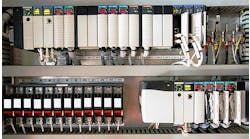Jim Montague is the executive editor for Control. Email him at [email protected].
"Mr. Bond, they have a saying in Chicago: 'Once is happenstance. Twice is coincidence. The third time, it's enemy action.' "—Auric Goldfinger in Ian Fleming's Goldfinger.
I've always enjoyed this quote from James Bond's arch villain, but I never thought I'd experience it directly. Let me explain.
As you might know, I call or email dozens of sources for interviews. However, sometimes people call me, asking to talk about a variety of topics, usually how terrific their product is. But, I was surprised when in the space of one week in February, I was asked to take calls from three different semiconductor manufacturers about how their chips could perform many of the same functions as PLCs and their supporting Ethernet networks. Of course, microprocessors have served inside industrial components for many years, but now it appears that the chipmakers are taking a more direct role and are less content to labor away in obscurity inside someone else's modules.
First, Intel's Internet of Things (IoT) Solutions Group (ISG) told me about its Industrial Solutions System Consolidation Series embedded virtualization product that allows OEMs, machine builders and system integrators to merge and manage multiple discrete systems into one machine. Set to launch in 2014, this solution consists of an embedded computer with an Intel Core i7 processor and a pre-integrated virtualization software stack, including Wind River's Hypervisor preconfigured to support three partitions running two instances of Wind River VxWorks for real-time applications, and one instance of Wind River Linux 5.0 for non-real-time applications.
Also read: Changing Trends: PLCs, PACs, PC-based controls, FPGAs or even DCS?
Tim Appleton, Intel ISG's industrial marketing manager, reports that combining operating system (OS), hypervisor, HMI and security functions will make it easier for builders to construct and run virtual machine functions, and that its OS can serve as a home for software-based PLC applications.
Second, Uday Mudoi, Vitesse Semiconductor's product marketing VP, reported that his company will soon release its SimpliPHY processors, VSC8501 single and VSC8502 dual, which are designed to make it easier and use less energy to run synchronous, secure, gigabit Ethernet networking tasks and IoT functions. A third processor, VSC8514 quad Cu PHYsrsis, will run on other types of copper wiring.
Third, Texas Instruments (TI) added its recently integrated motor control, position feedback and the top five fieldbus communication protocols on its Sitara AM4x processors, which it launched last November. However, it's also been collaborating with 3S on using CoDeSys 3.5 PLC software, and the two will soon launch their Sitara AM5x processors, which will integrate two ARM Cortex-A15 cores.
The CoDeSys runtime software is operating as an application on top of a Linux 3.8.13 real-time kernel, and its subsequent PLC application contains a two-axis motor-control system that's using CoDeSys Softmotion module and an embedded EtherCAT master to drive two off-the-shelf EtherCAT servomotors.
"Having motors and communications on the same device allows drives to talk to higher-level motion functions, gives users a new architecture for connecting motors, and means better intelligence, diagnostics and performance," explains Thomas Leyner, TI's system applications engineer.
So what's really going on here? Well, these announcements could simply coincide with last month's Embedded World or last fall's SPS/IPC/Drives tradeshows, or be linked to other easily explainable events. However, I think this might be just what they want us to think.
I believe the PLCs' number might be up. Just as pneumatics were replaced by relays and relays by PLCs, I think microprocessors and their software simply are continuing their march onto the plant floor, trampling traditional hardware and reaching the point where PLCs in many applications are going to be irrelevant and unnecessary quite soon.
In fact, unrelated to the news from Intel, Vitesse and TI, several recent interviewees pointed out that machines and equipment with Internet protocol (IP) addresses and Ethernet networking can report to and be controlled by upper-level PCs, and may eliminate the need for PLCs altogether. I know this isn't news to some people, but it can still be a shock when that other shoe falls, and a longstanding part of your industry dries up.
Personally, I'm hoping that another rule begins to take effect; namely, as soon as someone writes an epitaph for a technology, it immediately experiences a renaissance. So PLCs may continue to grow among a huge installed base that's still moving from older controls and manual manufacturing methods. Or those applications could leapfrog right to Internet-enabled, virtual PC-based control. Eek.






